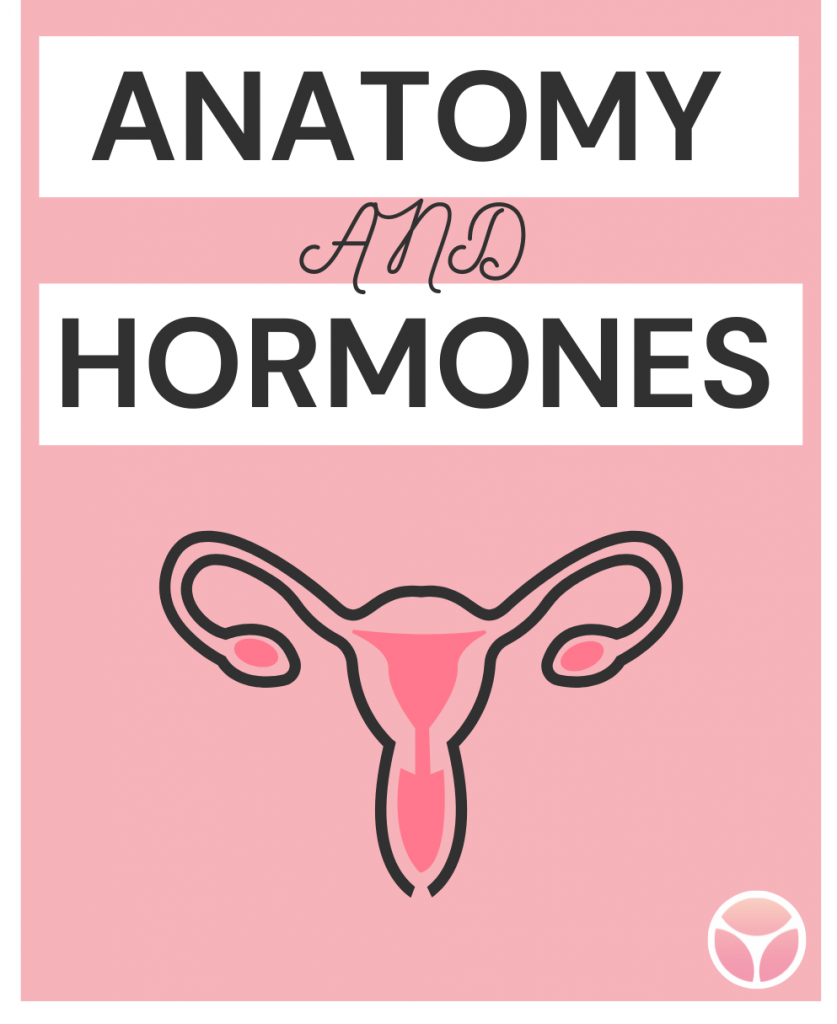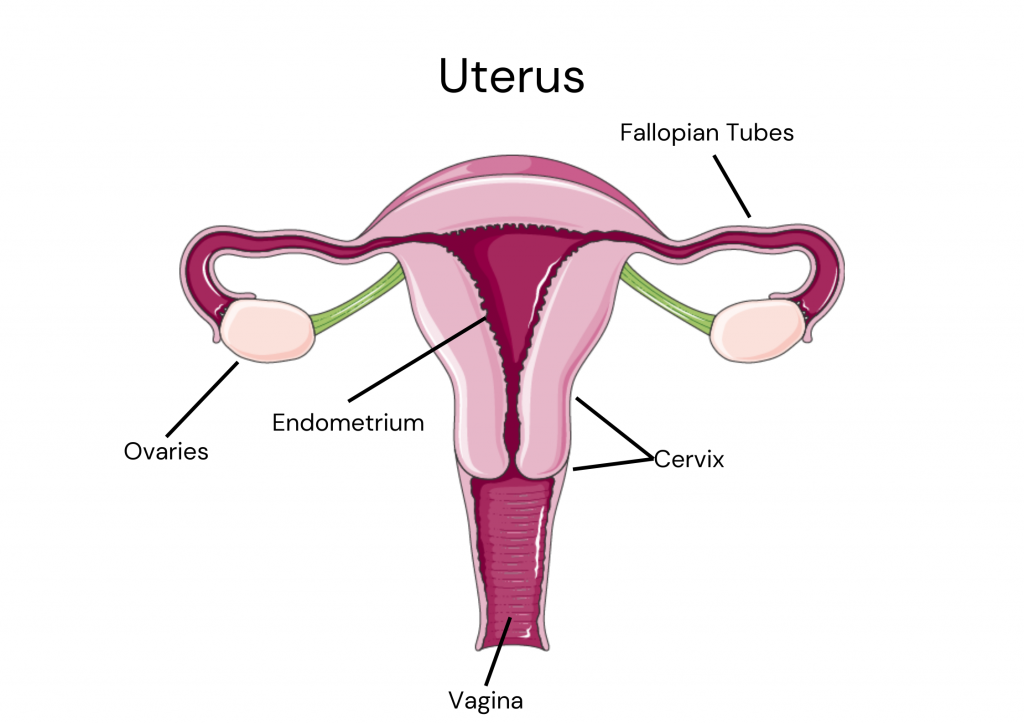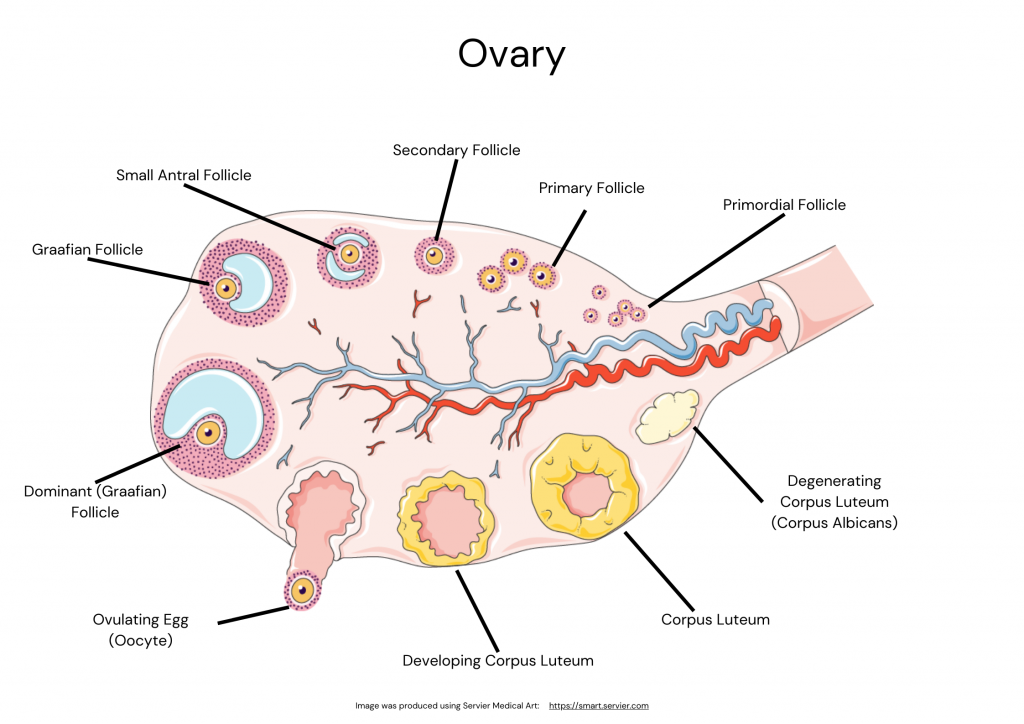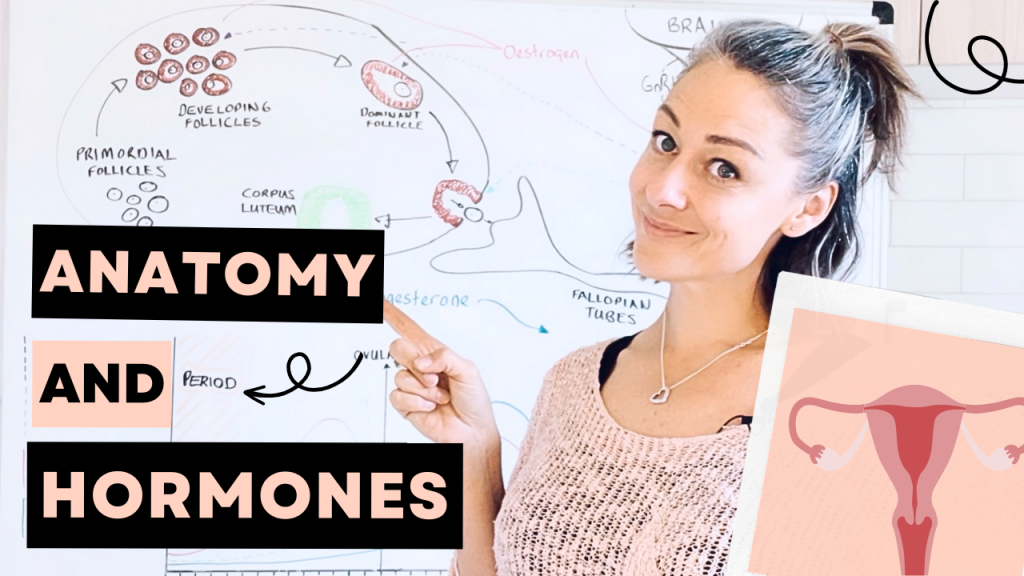
If you want to understand your periods and your menstrual cycle, it’s crucial to start right from the beginning. I know anatomy might sound boring, but remember, this is your body we’re talking about. Each one of us deserves to be knowledgeable about our bodies, and truly understand the anatomy and hormones of our menstrual cycle.
The female reproductive system is amazing, your anatomy holds the power to love, experience pleasure, and birth new life into the world. It’s time to get to know the anatomy and hormones that make your menstrual cycle possible.
Understanding the Basics
The female reproductive anatomy includes the:
- Hypothalamus (in the brain)
- Anterior pituitary gland (also in the brain)
- Ovaries
- Follicle (within the ovaries
- Oocyte/ egg (within the follicle)
- Fallopian Tubes
- Uterus
- Endometrium (uterine lining)
- Cervix
- Vagina
- Vulva

The main hormones are:
- Gonadotropin Releasing Hormone (GnRH)
- Follicle Stimulating Hormone (FSH)
- Luteinising Hormone (LH)
- Oestrogen
- Progesterone
Master Control: The Hypothalamus and Pituitary Gland
Our journey begins in an unexpected place: the brain. Specifically, the hypothalamus, a small part positioned in the centre of our brain, initiates hormonal communication. Just beneath it lies the anterior pituitary gland, a pea-sized powerhouse responsible for coordinating our reproductive hormones and system. These two structures serve as the master controllers of our anatomy and hormones that govern our menstrual cycle.
The Hormonal Symphony: GnRH, FSH, and LH
The hormonal cycle starts with the secretion of Gonadotropin Releasing Hormone (GnRH) by the hypothalamus. This triggers the anterior pituitary gland to release Follicle Stimulating Hormone (FSH) and Luteinizing Hormone (LH). Before puberty, GnRH is released at a steady rate. After puberty, the frequency and strength of these pulses change, determining the quantity of FSH and LH produced. This absolutely blows my mind! Just by changing the pulsatile nature, it results in an entirely different hormonal response. Both FSH and LH signal the follicles within the ovaries and instruct them what to do next.
Ovaries

You have two ovaries on each side of your uterus. Within these ovaries are many follicles, each housing an oocyte, which we commonly refer to as eggs. FSH instructs these follicles to grow, and as they do, they produce oestrogen. Amidst these, one follicle each menstrual cycle emerges as the Dominant Follicle, destined to release your egg.
The Dance of Hormones: Oestrogen, LH, and Ovulation
Once the oestrogen, produced by the dominant follicle, reaches a peak level in the blood it signals the brain to release Luteinizing Hormone (LH). This surge of LH triggers ovulation, where the follicle ruptures, releasing the egg into your fallopian tubes.
Fallopian Tubes
You have two fallopian tubes that extent from the top right and left of your uterus. These 10cm muscular tubes reach out to your ovaries to collect your eggs. These tubes are lined with microscopic hairs called cilia, which help move the egg towards your uterus.
Corpus Luteum and Progesterone
After ovulation, the ruptured follicle transforms into the Corpus Luteum, a temporary endocrine structure. This gland is responsible for producing Progesterone, a crucial reproductive hormone. As your egg begins its journey down the fallopian tubes towards the uterus, Progesterone production is in full swing.
Endometrium: The Potential Haven
Meanwhile, your endometrium, the lining of your uterus, thickens due to the influence of oestrogen and progesterone, preparing for a potential pregnancy. If conception doesn’t occur, progesterone and oestrogen levels decline, signaling your endometrial lining to shed, resulting in your menstrual period.
A Quick Recap of the Hormones of the Menstrual Cycle
- Hypothalamus secretes GnRH, signalling the pituitary gland to secrete FSH.
- FSH tells your follicles to grow and as they do they produce oestrogen.
- The peak oestrogen levels signal the brain to release LH, which triggers ovulation.
- After ovulation, the follicle becomes the corpus luteum, producing progesterone.
- No pregnancy, oestrogen and progesterone levels drop, which signals menstruation.
Let’s NOT Forget the: Cervix, Vagina, and Vulva
Your cervix, the lower part of your uterus, acts as a gateway, allowing blood and sperm to pass through. It produces cervical fluid (aka ovulation mucous), aiding sperm survival within your reproductive organs for up to 5-days. And equally importantly, it can stretch up to 10cm during childbirth. The cervix is also the location doctors will check for abnormal cells during a pap smear.
Next in line is your vagina, a muscular passage around 10-15cm long reaching from your vulva to the cervix. Its elastic nature allows it to stretch during intercourse and childbirth (thank goodness) and is the route for menstrual blood flow and cervical fluid.
Last but not least, the often-overlooked vulva. The vagina usually gets all the credit. The vagina is the passage from the vulva to the cervix. All the anatomical bits that are external to the vagina are what we call the vulva. This includes: the mons pubis, labia (majoris and minoris), clitoris, urethral opening, and vaginal opening. The vulva “gives life” during childbirth and also has the sexual function of providing pleasure. So, let’s give her a little more respect.
Empowerment Through Knowledge
In summary, this knowledge is not just about biology; it’s about empowerment. Understanding your body equips you with the ability to make informed decisions. Furthermore it helps you fosters self-love, and opens doors to a healthier, more conscious way of living. So, join me on this journey, embracing the wisdom of your body and celebrating the incredible capabilities it holds.
If you are more of a visual learner, I have an accompanying YouTube video “Female Reproductive Anatomy & Hormones for people with Periods”, so please feel free to check that out here.
Stay tuned for my next article, where we’ll journey through the phases and stages of the menstrual cycle, exploring the hormones in even greater depth.
Be curious, embrace your body and celebrate all that you are.
Happy learning!
Amanda xx
